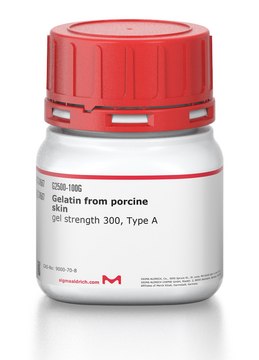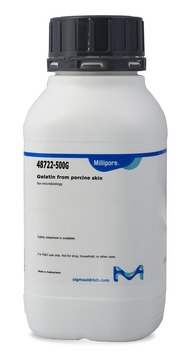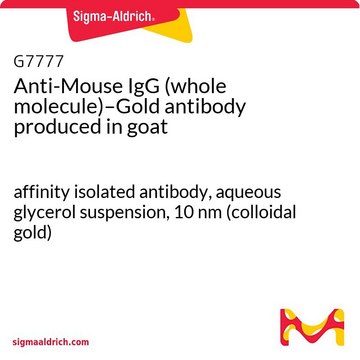G9391
Bovine Gelatin
from bovine skin, Type B, powder, suitable for cell culture
Sign Into View Organizational & Contract Pricing
All Photos(2)
About This Item
Recommended Products
Product Name
Gelatin from bovine skin, Type B, powder, BioReagent, suitable for cell culture
biological source
bovine skin
Quality Level
sterility
sterile
type
Type B
product line
BioReagent
form
powder
packaging
pkg of 100 g
pkg of 500 g
technique(s)
cell culture | mammalian: suitable
gel strength
~225 g Bloom
solubility
H2O: soluble 50 mg/mL, hazy to strongly hazy, faintly yellow to yellow
shipped in
ambient
storage temp.
room temp
Looking for similar products? Visit Product Comparison Guide
General description
Gelatin is a heterogeneous mixture of water-soluble proteins of high average molecular masses, present in collagen. Proteins are extracted by boiling the relevant skin, tendons, ligaments, bones, etc. in water. Type A gelatin is derived from acid-cured tissue. Type B is derived from lime-cured tissue. Gelatin is a hydrocolloid and is rich in glycine, proline and hydroxyproline, which impart structural stability. It is synthesized from the alkaline digestion of collagen from bovine skin and is referred as type B. It has wide applications in food industry. Gelatin takes up random coil structure after digestion from the triple helical collagen. The most common source for industrial production of gelatin is slaughter byproducts. The type A gelatin from porcine and type B differ in their isoelectric pH. The N-terminal sequence of bovine gelatin is unique for its identification. It has gelling property and displays surface behaviour for use in foams and adhesions.
Application
Gelatin has been used:
- in coating cell culture to improve attachment of cells,
- in PCR to stabilize Taq DNA, as a blocking reagent in Western blotting, ELISA, and immunochemistry,
- as a component of media for species differentiation in bacteriology
- as a biocompatible polymer
- as a delivery vehicle for the release of active biomolecules
- in the generation of scaffolds for tissue engineering applications.
- to study long-chain fatty acid-induced changes in gene expression in neonatal cardiac monocytes
- to study to test mobilization of capillary endothelium in-vitro induced by effectors of angiogenesis in vivo
Biochem/physiol Actions
Gelatin is commonly used in place of collagen due to its reduced immune antigenicity and cost-effectiveness. This macromolecule contains arginine-glycine-aspartic acid (RGD) sequences, known to promote osteoblast adhesion and enhance osteointegration. Its similar properties make gelatin a favorable substitute for collagen in many applications. Gelatin finds extensive use in enhancing cell attachment across various cell types. Moreover, it serves as a biocompatible polymer with applications in delivering bioactive molecules and creating scaffolds for tissue engineering purposes. This versatile material contributes to improved cell adhesion, controlled release of bioactive substances, and the development of tissue-engineered scaffolds.
Components
Gelatin is a heterogeneous mixture of water-soluble proteins of high average molecular masses, present in collagen. Proteins are extracted by boiling the relevant skin, tendons, ligaments, bones, etc. in water. Type A gelatin is derived from acid-cured tissue. Type B is derived from lime-cured tissue.
Caution
Dry gelatin, when stored in airtight containers at room temperature, will remain unchanged for many years. When heated at 100°C in the presence of air, it swells becomes soft and disintegrates to a carbonaceous mass with evolution of pyridine bases and ammonia.
Preparation Note
This product is derived from bovine skin. Gelatin is soluble in hot than in cold water. It is practically insoluble in most organic solvents such as alcohol, chloroform, carbon disulfide, carbon tetrachloride, ether, benzene, acetone, and oils. The Bloom number, determined by the Bloom gelometer, is an indication of the strength of a gel formed from a solution of the known concentration. The Bloom number is proportional to the average molecular mass. Bloom numbers of porcine skin Gelatin vary from 90 to 300 g.
Storage Class Code
11 - Combustible Solids
WGK
nwg
Flash Point(F)
Not applicable
Flash Point(C)
Not applicable
Personal Protective Equipment
dust mask type N95 (US), Eyeshields, Gloves
Choose from one of the most recent versions:
Already Own This Product?
Find documentation for the products that you have recently purchased in the Document Library.
Customers Also Viewed
Our team of scientists has experience in all areas of research including Life Science, Material Science, Chemical Synthesis, Chromatography, Analytical and many others.
Contact Technical Service









